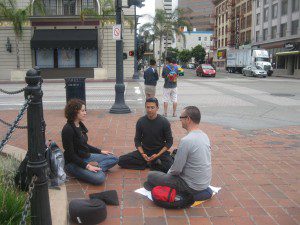The Christian theologian Karl Barth said that one needs to preach holding the Bible in one hand, and a newspaper in the other. That reminds me of a recent flurry of thoughts and comments on various contemporary Buddhisms in the West, increasingly called Buddhist modernism.
The knock on this contemporary and mostly, although certainly not exclusively Western Buddhism, what was at one time called a Protestant Buddhism, is that it claims to offer a stripped down and spare form of the Dharma, with none of the embarrassing bits. Among the critiques is how Buddhist modernism is not only dismissive of, but generally ignorant of the richness and complexity of the Buddhisms practiced in East and South Asia.
Some of this is true. I’m sure. But, I’m also aware that buried in the critiques are often subtle and on occasion not so subtle calls to the old time religion. They recoil at the new dialogues and seem really seem to want a Buddhism untarnished by the soiled hand of modernity. Or, let’s be frank, self-analysis. Or, any criticisms of the received. So, its own problems. Frankly, I find this either/or choice, a stripped down, some bare reductionist Buddhism or some particular cultural expression of sufficient antiquity as the only way not very useful. And, in fact, not what the choices really are.
Me, I’m pretty much fully a part of the contemporary phenomenon, what I’ve mostly called liberal Buddhism, although I’m aware that term seems to have no fan base beyond me. That noted as one who generally identifies with this emerging Buddhism, I find the point of the project of seeing the hurt of the world, that clinging to a passing self as a large part of that problem, and embracing a path of meditation, moral harmony and a lodestar of nondual insight, is shared by us all. However, for most who would own the modernist or liberal or protestant title, all takes place in this, one life.
For the modernist Buddhist the critical distinction is that “one life.” The issue is not really whether there are supernatural beings, or heavens and hells. So, me, I don’t think so. But the “truth” of my religion doesn’t matter whether there is or is not.
Still, the issue that divides many of us is rebirth, and how many of us see the whole deal all here and now. And it is the only “reductionism” in my Buddhism.
No extra. No next. This is the radical at the heart of much of contemporary or modern or protestant or liberal Buddhism. However. The core insights of Buddhism, the three marks, anita or impermanence, anatta or non self, and dukkah or disatisfaction, or sadness, or unsatisfactoriness, are right at the heart of this Buddhism. And this is my point. Noticing and dealing with those three marks are the real core of Buddhism not some post-mortem reanimation.
And, yes. That one life is both a very small thing, and is a major game changer for how Buddhism is encountered. It rejects, if not as a possibility, as any major concern, the idea of rebirth as a postmortem life, and with that, a focus on or concern with future awakening.
If, and I’m confident enough to put all my eggs in the basket, there is one life, then the point of my practice and faith is focused entirely on what is at hand. And, yes, it is more straight forward, and a bit stripped down. But it has some strong principles. The disciplines of sitting down, shutting up, and paying attention are not to be ignored. Finding the harmonies of my actions and thoughts are critical. And that means now. And, perceiving in flashes and as a growing depth of insight, that nondual reality is always before me.
So, yes. The Sutras (or, for me, the koan literature and other classics of most concern in the Chan and Zen spiritual world) in one hand. We need the wisdom of our elders.
And, absolutely, a newspaper, or websites and social media, in the other. Keeping in touch with the news of the day. The matter at hand. This. Always this.
The healing gift of our new vision of the Dharma. Always needful of enriching. And already healing many broken hearts.
The picture is from Sweetwater Zen Center.













